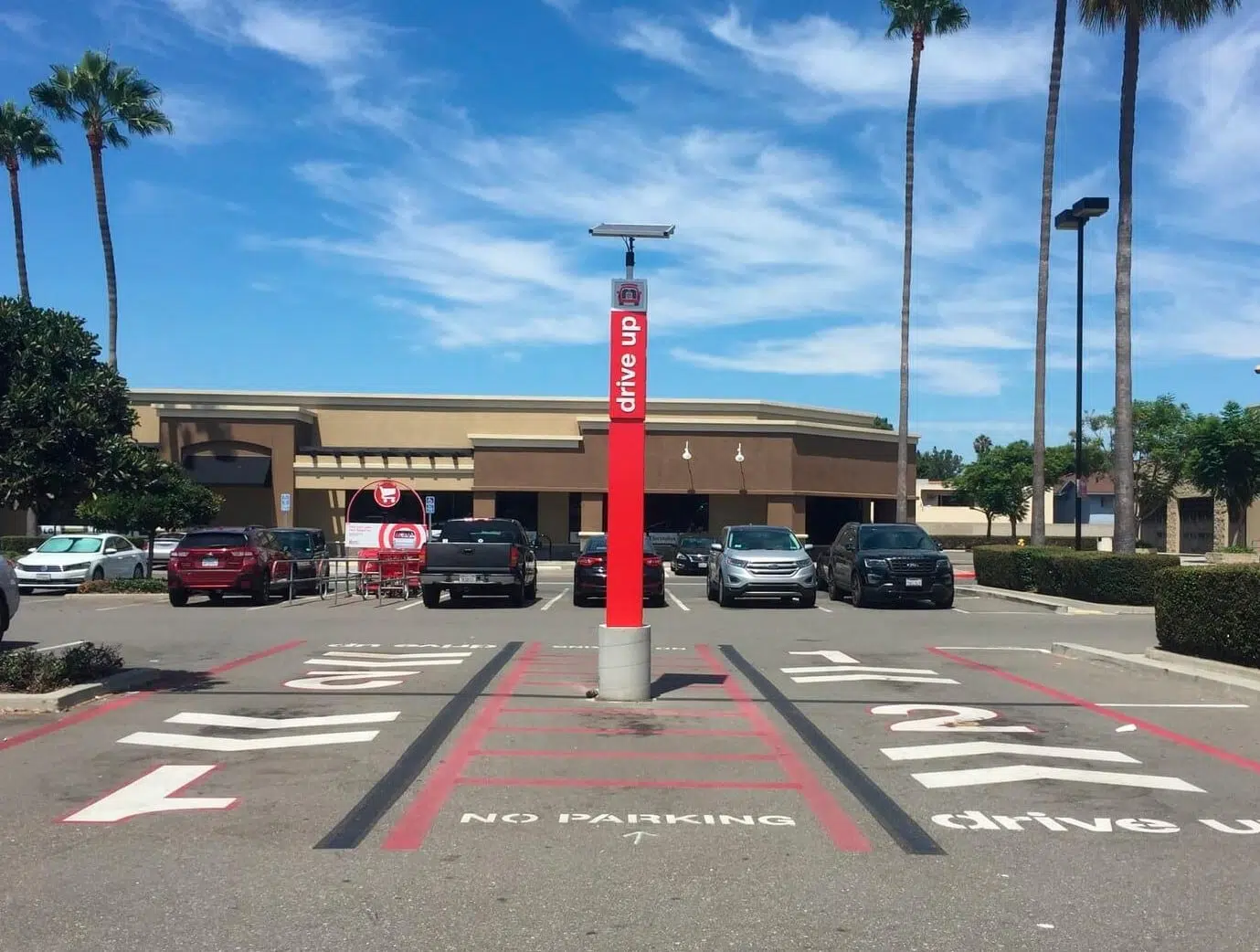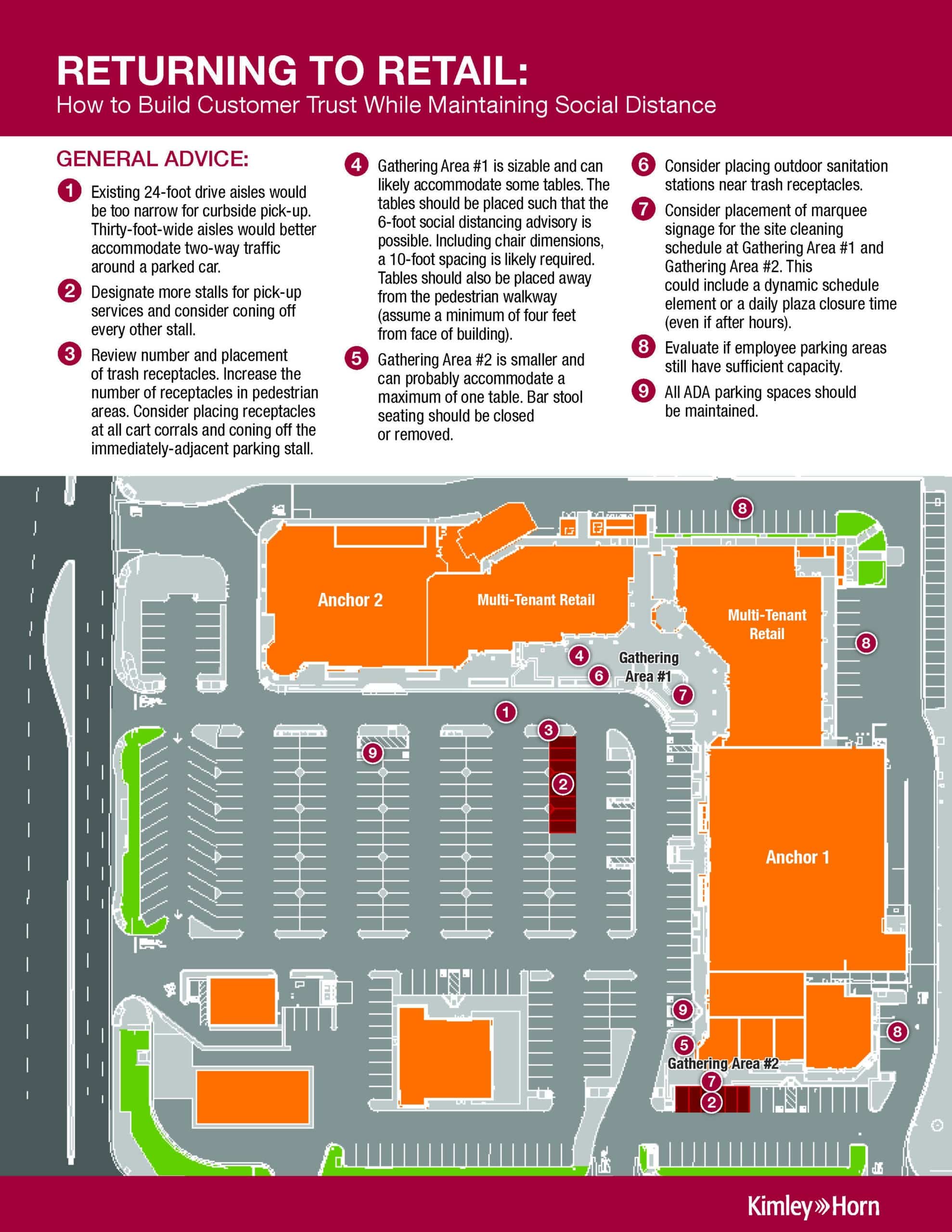- May 4, 2020
- COVID-19, Perspectives
Returning to Retail: How to Build Customer Trust While Maintaining Social Distance
Listen to the recorded webinar, where Kimley-Horn Experts share best practices on Returning to Retail.
What will the “new normal” look like in a month, or in six months? How about in one year? These are the questions we must consider when we return to brick-and-mortar retail.
Just a couple months ago, shopping centers were buzzing with people going out for food and goods, enjoying open spaces, and pumping money into the economy. Because of COVID-19, shopping centers have taken a drastic turn and are now incorporating social distancing efforts like curbside pick-up and intentional spacing in lines and parking. When businesses can reopen and we no longer need to shelter in place, consumers will not immediately go back to their old ways. While some will return right away, others will need time to feel comfortable going out. Retailers that take a consistent approach to design and operations will give a greater sense of security to customers and tenants. This approach and its application must also be done correctly from the beginning. While the situation is fluid, and can and will evolve, constantly changing your approach could erode public trust.
Below are some best practices and a conceptual site plan that shopping centers can reference to build consumer trust and thrive in our “interim new normal.”
Use Signage, Wayfinding, and Branding
Good design and operations can reduce potential customer conflicts by encouraging people to maintain social distance and showing them how. This can be done through proper, branded signage and wayfinding. Marketing material such as social media, websites, and mailers can depict new features/practices throughout the center. If your center’s goal is to control the flow of pedestrian and vehicle traffic, increased wayfinding is important. You can also implement increased branded signage for parking stalls assigned for pick-up, sidewalk or pavement markings related to social distancing, and temporary signage for revised recommended maximum occupancies.
When renovating centers with new sidewalk and plazas, consider using alternating colors of concrete in six-foot wide bands. This approach can help people subconsciously recognize distancing, combining purpose and aesthetics. Adopting a standard of six-foot score lines could be a less costly alternative.
Add Temporary Loading and Unloading Zones
Similar to the hospitality and travel industry with valet options and specific zones for rideshare app pick-up areas, temporary loading and unloading zones should not materially interfere with the overall site access. Before implementing these zones, designate a specified distance from the main entrances and driveways. If curbside, these zones typically work best if there are at least two to three car-widths of capacity, so about 50 feet minimum. Maintaining fire access is still required, so consider asking the fire department if they will allow curbside pick-ups on fire lanes if two-way traffic adjacent to a curbside loading zone is maintained. There are also removable options for setting aside loading areas if they are intermixed with drive lanes. If tenants provide extensive delivery services, a portion of the parking lot could be devoted to a queue. With correct signage, you could designate parking stalls for restaurants and delivery services such as Postmates, GrubHub, Door Dash, and Uber Eats. In these areas, it’s advisable to cone off every other parking stall due to high turnover and increased interactions.
Implement Parking Lot Safety Measures
You can implement intentional social distancing within parking lots by coning off every other parking stall. All ADA stalls should be kept open, since the loading zone between stalls maintains most social distance recommendations. Owners can work with tenants to more clearly define employee parking areas with signage, and consider increasing the amount of employee parking for tenants. High-turnover areas such as cart corrals and gas pumps could include hand sanitizer stations and trash receptacles. Coning off a parking stall adjacent to cart corrals could also help to maintain social distancing.
Sanitize Pedestrian Areas and Gathering Spaces
Providing sanitary pedestrian areas and gathering spaces where social distance can be maintained will build customer trust. Signage related to the area’s cleaning frequency and when it will be closed shows the proactive steps taken for cleanliness and safety and will also help ease tensions. Adding permanent structures for hand sanitizer will allow people to find them easily and consistently. Increasing the number of trash receptacles allows customers to remove personal protective equipment (PPE) and dispose of it safely and properly.
Considerations for social distancing in these spaces may include one-way walking paths where feasible and removal or rearrangement of furniture. For tenants that require outdoor queuing, visual social distancing cues can be provided on the ground surface or closer to eye level.
Gather Data to Continually Improve
Compiling data will help ensure that the approach and application of COVID-19 design and operation practices can adjust with the changing needs of both customers and tenants. While we have data on overall traffic reductions after social distancing started and non-essential businesses closed, counting driveway traffic on some selected sites could begin to inform what the parking demand is in a time period where social distancing is still required but shopping centers are open for business. While driveway counts might not decrease as much as expected, average parking time could decrease. Active parking space availability monument signs in parking garages could also be implemented in surface parking lots with a simple “in/out” counter. This data, along with parking counts and cell phone data aggregators can trace trips and provide more insight on average park time as well as feed an app for real-time data on parking center congestion. This data could then be compared to typical parking factors to see how patterns are changing on a week to week basis.
Our Experience
Kimley-Horn has adapted retail sites nationwide—helping our clients increase their capacity for Grab-and-Go curbside services. With over 2,000 related in-vehicle projects completed for local and national clients, our expertise includes negotiating local permitting requirements, integrating technology to communicate with customers, planning for queuing and stacking, and adding visible signage for the following Grab-and-Go alternatives:
- Converting parking stalls to pick-up stalls
- Adding drive-thru capacity (including double drive-thru)
- Implementing urban and street-front curbside pickup
We are hopeful these best practices will help shopping centers successfully reopen and build the trust customers will need to comfortably return. If you are a developer or property owner and need assistance on a specific site or need help implementing a consistent plan for multiple sites in your portfolio, please contact your existing Kimley-Horn partner or email [email protected] or [email protected].


